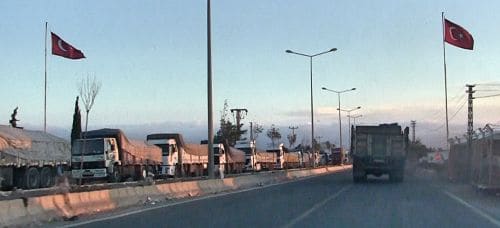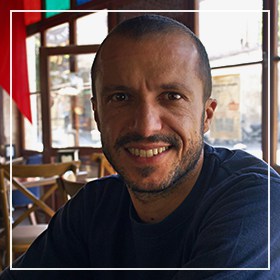During World War II, Ruth Benedict conducted research about Japan at a distance. Challenging the stereotypical image of the white male researcher risking his life alone under fire, Benedict overcame the problem of accessing the no-go war zone by interviewing Japanese informants in the US, doing ‘remote ethnography’. The result, her book The Chrysanthemum and the Sword, is one of the most famous anthropology books among readers outside the profession.
Nowadays the effects of modern remote-controlled war are a topic of research in itself, from the bombing of Guernica during the Spanish Civil War to the current strikes in Syria. The latter is a paradigmatic remote war, in which the airstrikes may be decisive in the day-by-day battle but being in the field remains a basic requirement to ‘win’.
The Syrian conflict started as a civil revolution evolving into a bloody proxy war between global powers supporting different factions. It has created a combination of risk dynamics keeping hidden what is happening into the country. Death and kidnappings constitute clear risks for journalists and aid workers whose press vests and NGO T-shirts are no longer protecting them in battle. The same applies to researchers, who face similar security constraints.
All Syrians are overcoming the war limitations using information collected by social networks, websites and VoiP technologies broadcasting news 24/7. Global media are also covering the war but due lack of access and partisan positions there is no guarantee of truthful information from these sources.
Publics around the world are aware of what is happening in Syria but also tired of war images while powerful governments are not committed to stop the conflict. Thus, by now, the only support to the Syrian population is humanitarian action.
Humanitarian remote management in Syria
Syria is the biggest humanitarian challenge since World War II. The aid industry has been overwhelmed by a lack of funding, political polarization and difficulties of accessing millions of people in need. Medical facilities, humanitarian convoys and aid workers have been targeted militarily. Humanitarian access changes constantly depending on the military group who has the power in each area. In this context, humanitarian delivery is always an active process of transformation and adaptation.
Aid operations are concentrated along two main axes: from Damascus to areas controlled by the Syrian government; and from neighbouring countries to areas of opposition to the Syrian government. As for the latter, successive UN resolutions (2139, 2165, 2191, 2258) have created an international legal framework for a ‘humanitarian cross-border operation’ from Jordan, Iraq and Turkey. Similar practices of ‘remote control’, ‘remote management programming’, ‘limited access programming’ or ’remote partnership’ have been deployed in many varying ways in Somalia, Afghanistan, Sri Lanka and Sudan. Existing research suggests that such remote programming transfers risks and redistribute the responsibilities from internationals to national or local aid workers and organizations, who carry out the dangerous frontline tasks.
Consequently, the remote management from third countries and the implementation inside Syria implies crossing national borders, negotiating with different governments and opposition groups with various political agendas, dealing with national and international laws, administrations, procedures and languages; and it moreover involves overlapped categories of local, national and international aid workers and organisations with unequal power and practices.
Aid work from ‘Little Aleppo’
I have studied the aid workers and organizations whose objective is delivery relief assistance crossing the Turkish-Syrian border. I have been based in the city of Gaziantep, near the Syrian border. This Turkish city is a ‘little Aleppo’, hosting more than 300,000 Syrians. Only 118 km separates both cities, so close and so far at the same time.

Programmes are managed by NGOs, UN agencies and other humanitarian actors from their offices established in Gaziantep where Syrian, Turkish and international aid workers take big decisions, dealing with donor relations, writing project proposals, controlling budget, and so on. Work in this volatile environment is a big challenge and remoteness is always in process of reconfiguration.
All aid workers in Gaziantep are facing similar problems mostly derived from the remote nature of work such as limited previous experience, lack of coordination, weak accountability and deficiency of reliable information. The impossibility of being there is also a common frustration: they cannot see the projects in Syria first hand. Only a few Syrian aid workers have been able to go back and forth. In addition, while in Gaziantep the officers have good living conditions, Syrian aid workers implement projects inside Syria under fire – one of the riskiest jobs in the world.
Aid workers also face other frustrations and imaginaries about humanitarian remoteness. Not many Turkish and international aid workers have been in Syria and/or speak Arabic and their limited knowledge and experience about/in the country have produced a total dependency on Syrian partners and Syrian staff for project implementation.
Some Syrian aid workers are highly valuable because they have previous face-to-face relations, local knowledge and experience overcoming access problems: erasing the remoteness. Their frustration is due to their need to be in touch with their people inside the country facing connectivity concerns and the pressure of implementing projects while coping with their sense of personal loss.
Humanitarian aid as strategic resource
‘Remote-controlled humanitarianism’ is a growing trend, as seen in the proliferation of workshops and initiatives for different operational modes and remote sensing capabilities. Innovative tools to collect and analyse information, new job positions and original uses of technology and big data have been developed in Syria to remotely manage this long-distance relief operation.
In the past five years, an enormous quantity of resources —people, ideas and commodities— have been moved across borders. Donors want to be there and Syrian workers have already got experience in the aid business. This has created some normalization of remote management to fulfill the requirements of the aid system under the coordination of UN agencies, creating new power relations in decision-making and resource allocation.

The economic dynamics of operations are marked by funding appeals that are not fulfilled, creating a race between humanitarian actors for scarce resources. Meanwhile, a big corruption case in procurement has affected operational principles. Sometimes the adjective ‘remote’ is used as an excuse to justify the lack of effectiveness in relief delivery while direct implementation in other settings has never been totally effective.
Moreover, the aid sector is transferring money remotely – via cash transfers, cash for work programmes and vouchers – into Syria. How is this impacting on local economies? With volatile prizes and lack of basic needs, how are these resources being used and how are they affecting power relations? Control of these aid resources is strategic for the Syrian Government and opposition groups while respecting humanitarian principles and measuring efficacy is essential for humanitarian actors. But, is the aid system able to retain control remotely? In essence, this would require additional adaptation of humanitarian tools, build trust and improve local actor capacities as well as more research and analysis.
Being there while being here
In war, remoteness is the impossibility of being there. Every war creates remote areas where physical participation is difficult for some people, especially researchers, aid workers and journalists, among other witnesses. Ruth Benedict could not go to Japan but this obstacle was, for her, an opportunity to develop alternative ways to do ethnographic research. If she had worked today, she would have used new technologies to overcome this distance, making people from the no-go areas more ‘accessible’.
Anthropologists can keep advocating for the need to ‘be there’ while defending ethnography at a distance as an imperfect but suitable tool to ‘be’ in no-go zones. In this vein, conducting our research among people who work remotely on crisis zones is one of many other ways of studying war at distance.
In this, we may learn from the struggles of aid workers to retain a remote presence. Being there is not always a pre-requisite to delivering aid effectively, even though operations do become considerably more complicated. Operations in Syria have been adapted to risk dynamics producing ways to manage remotely the delivery of humanitarian support, employing Syrians here to explain/manage the remoteness, and there to have a physical presence in Syria for implementing the projects. As a result, the construction of remoteness is a complex process between different aid workers and organizations with different frustrations, various imaginaries and the same humanitarian framework to overcome the difficulties and reach Syrians in need. The results will be far from perfect, but the alternative – to let Syria slip completely out of our field of vision – is much worse to contemplate.
Featured photo by neliO (flickr, CC BY-NC-ND 2.0)





